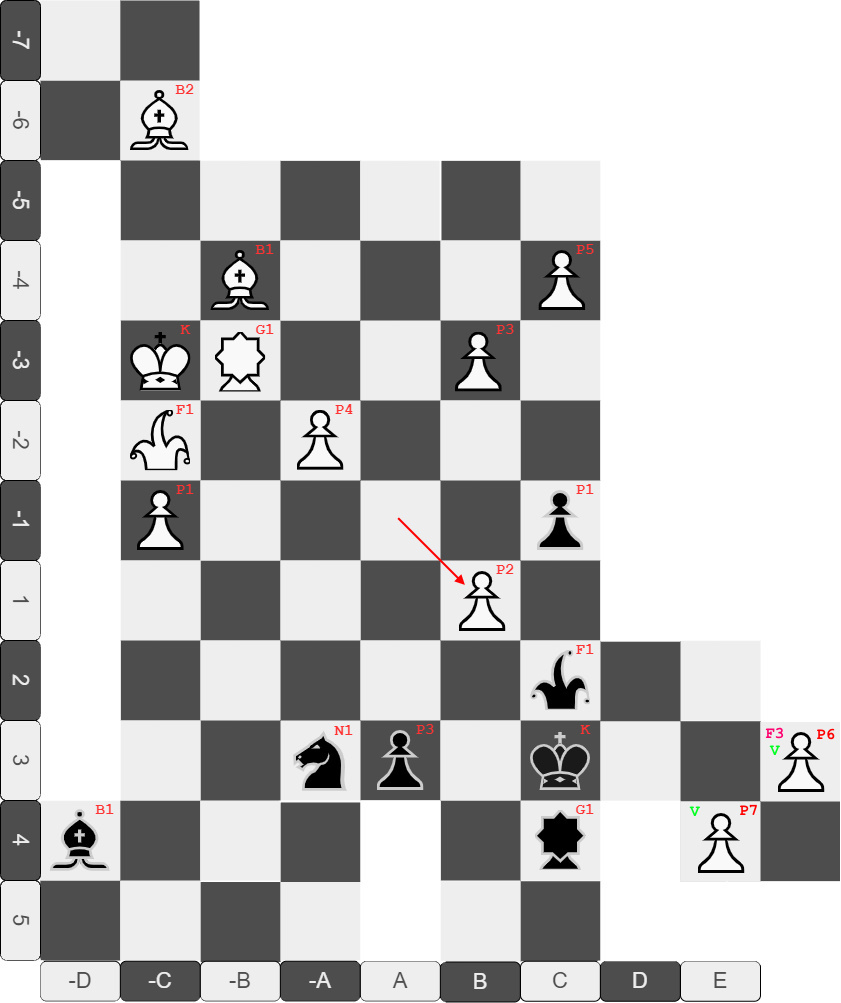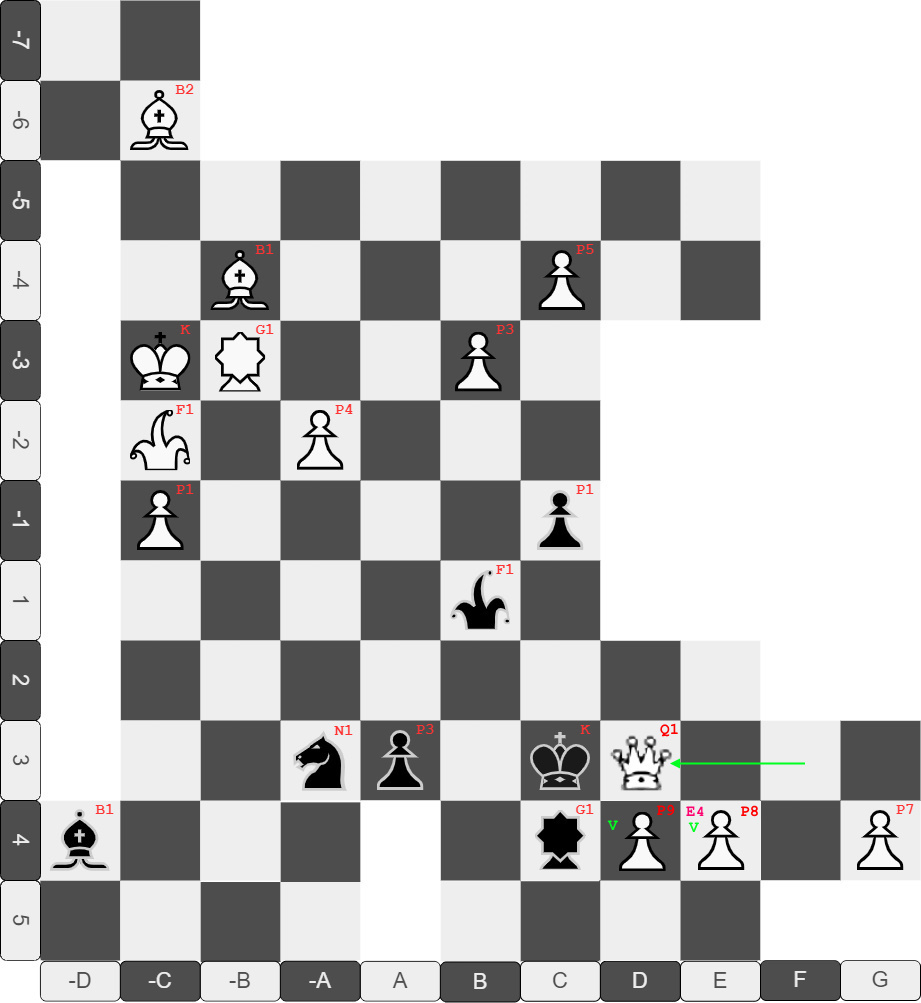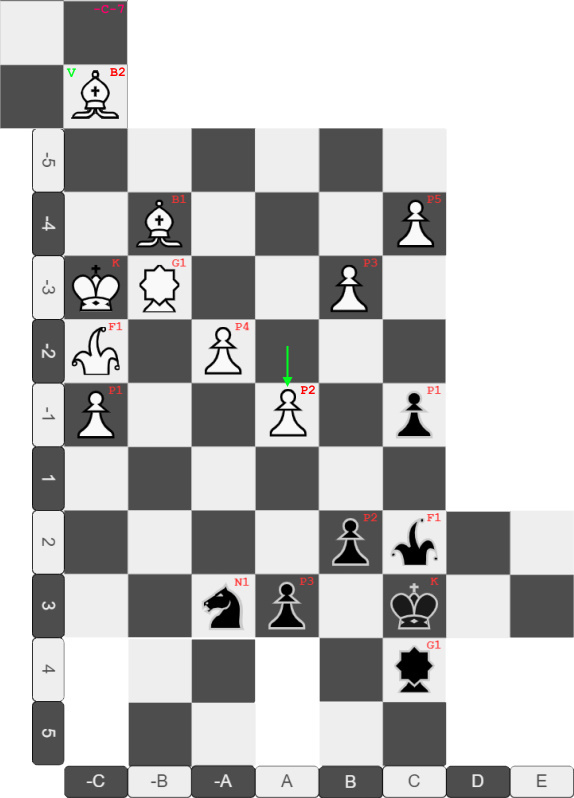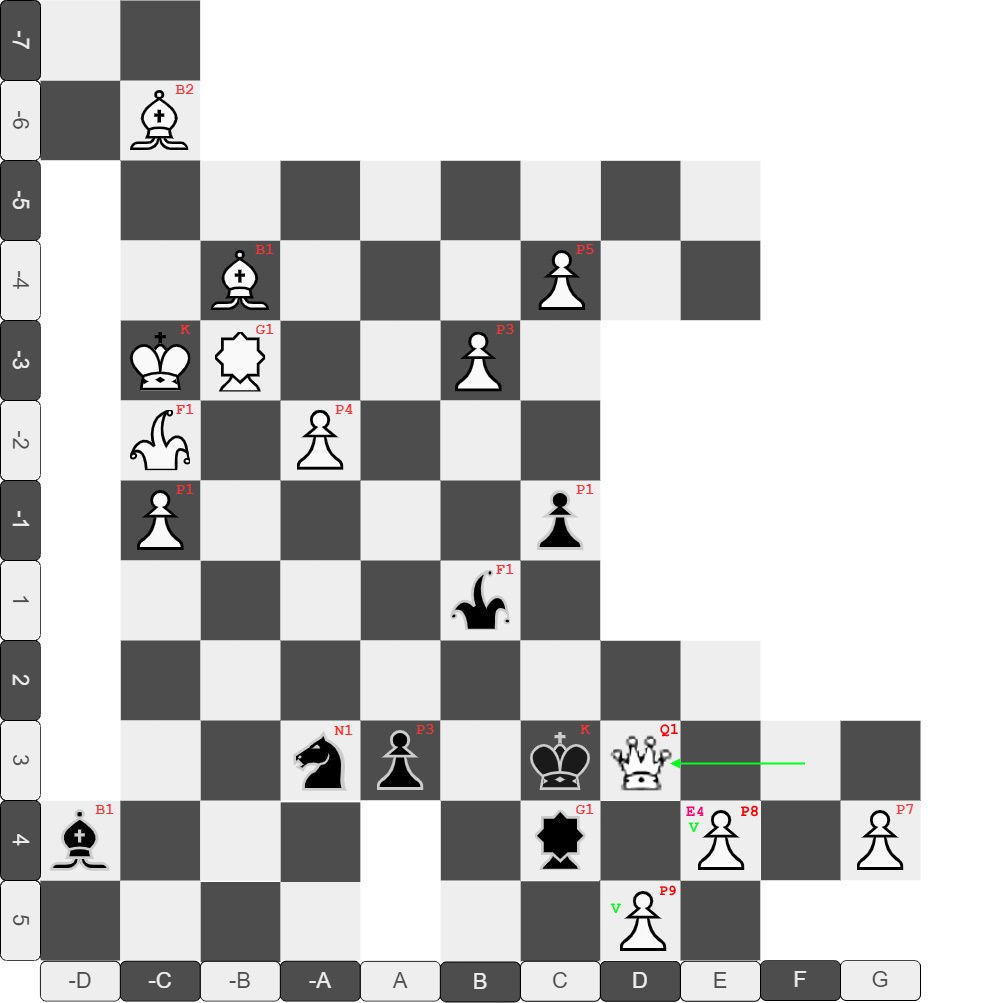Yep didn't see the move it was my error.wP4 with a double move to B-4. It didn't move, so it has the move available.
Pawns are counted as pieces, right?
You are using an out of date browser. It may not display this or other websites correctly.
You should upgrade or use an alternative browser.
You should upgrade or use an alternative browser.
SV Plays Infina-Chess
- Thread starter Planetary Tennis
- Start date
-
- Tags
- chess game why do i do this
Turn 4

RECORD
W1
wP3|-A-3>B-3
∆A-5
=wP4 -A-4
B1bP1|C1>C-1
∆E2
W2wP2|-B-2>A-2
∆-B-5
=wB1 -B-4
B2bG1|B3>C4
∆C4
=bN1 B4
wP4| -A-4>-A-2
∆C-5
=wP5 C-4
B3bN1|B4>-A3
∆-A4

Progress is made and the board grows, the black side hectic moving in its own way while the white moves in an ordered manner. Will chaos reign or is order the path?
Turn 3- SV is White
W 3
B 5
Fools moves like Knights
[]Piece
-[]New Location
[]Tile
-[]Location
-[]New Pieces
Vote closed
Turn 5

RECORD
W1
wP3|-A-3>B-3
∆A-5
=wP4 -A-4
B1bP1|C1>C-1
∆E2
W2wP2|-B-2>A-2
∆-B-5
=wB1 -B-4
B2bG1|B3>C4
∆C4
=bN1 B4
W3wP4| -A-4>-A-2
∆C-5
=wP5 C-4
B3bN1|B4>-A3
∆-A4
wP2|A-2>A-1
∆-C-7
=wB2 -C-6
B4bP2|B2>-B1
∆-C4
=bB1 -D4

More pieces are brought into play more angles of attack open. The first fork of the game is born the bishop threatens the pawn, and the pawns each other. New paths to each other's rear lines open, as new forces are brought to the field.
Turn 5- SV is White
W 2
B 4
Fools moves like Pawn
[]Piece
-[]New Location
[]Tile
-[]Location
-[]New Pieces
Last edited:
- Location
- St. Petersburg
Okay. This is me entering "I have no idea what I am doing" territory. Hopefully that answers the question why I put the Bishop down on Turn 2.
Please check the turn for following the rules.
[x]Piece
-[x] wP2| A-1xB1
[x]Tile
-[x] ∆F3
-[x] =wP6 F3; =wP7 E2

Please check the turn for following the rules.
[x]Piece
-[x] wP2| A-1xB1
[x]Tile
-[x] ∆F3
-[x] =wP6 F3; =wP7 E2

Last edited:
Okay Neville you have just one error I can see that is you can't place the new 2x2 overlapping the existing board.
Dammit. I hoped this was an allowed move. Unfortunate.
Can the pawns be promoted if there is no enemy Guard on the board?
[x]Piece
-[x] wP2| A-1xB1
[x]Tile
-[x] ∆G3
-[x] =wP6 F3; =wP7 G2

Edit: turn corrected.
Pawns can be promoted only adjacent to a guard, if none are on the board only on adjacent to the king. But the king can Capture promoted pawns if it is otherwise legal
Turn 6

RECORD
W1
wP3|-A-3>B-3
∆A-5
=wP4 -A-4
B1bP1|C1>C-1
∆E2
W2wP2|-B-2>A-2
∆-B-5
=wB1 -B-4
B2bG1|B3>C4
∆C4
=bN1 B4
W3wP4| -A-4>-A-2
∆C-5
=wP5 C-4
B3bN1|B4>-A3
∆-A4
W4wP2|A-2>A-1
∆-C-7
=wB2 -C-6
B4bP2|B2>-B1
∆-C4
=bB1 -D4
wP2| A-1xB1
∆G3
=wP6 F3
=wP7 G2
B5bF1| C2xB1
∆E-5

Fed into the war machine two pawns die. Sacrificed by each side. A fair trade? Or a waste of life? It matters not what they are, for they are pieces of no value but what they give to the coming victory.
Turn 6- SV is White
W 3
B 7
Fools moves like Pawn
[]Piece
-[]New Location
[]Tile
-[]Location
-[]New Pieces
- Location
- Canada
- Pronouns
- He/Him
I feel like Black might be saving up for a Queen.
- Location
- St. Petersburg
Uh-huh. WELL THEN!
[x]Piece
-[x] wP6| F3>D3 Q1++ (Double Check)
[x]Tile
-[x] ∆E4
-[x] =wP8 E4; =wP9 D4 ++ (Double Check)
Do you denote Check/Mate when placing a piece?

Please tell me if the turn is correct and what the rules for promotions are.
1) Can a newly placed (not promoted!) piece place the enemy King in check? (I can see no reason for why it can not, but...)
2) If a pawn was promoted last turn, does enemy Fool count as a pawn, or as a new spawned piece? (My guess is "pawn")
3) When does a passive promotion happen?
What happens if enemy King steps next to a pawn? In theory, that means you can promote the pawn, so logically a promotion can only happen at the end of the turn, or the King would place himself in Check, or start the turn in Check, both of which would be in violation of the rules.
Does it count as a separate turn, though, when it happens passively? Or do you get to move a piece AND promote any pawns that ended up close to enemy Guards?
[x]Piece
-[x] wP6| F3>D3 Q1++ (Double Check)
[x]Tile
-[x] ∆E4
-[x] =wP8 E4; =wP9 D4 ++ (Double Check)
Do you denote Check/Mate when placing a piece?

Please tell me if the turn is correct and what the rules for promotions are.
1) Can a newly placed (not promoted!) piece place the enemy King in check? (I can see no reason for why it can not, but...)
2) If a pawn was promoted last turn, does enemy Fool count as a pawn, or as a new spawned piece? (My guess is "pawn")
3) When does a passive promotion happen?
If a Guard steps close to my pawn, I can promote it. When do I? During the enemy turn, at the beginning of my turn, at the end of my turn? Can I move the passively promoted piece on the turn following the Guard's? What happens if the Guard stays in place and a pawn spawns next to it? When can I promote it?Guards can not capture pawns that have been promoted in the last turn, pawns can be promoted if a guard moves next to them.
What happens if enemy King steps next to a pawn? In theory, that means you can promote the pawn, so logically a promotion can only happen at the end of the turn, or the King would place himself in Check, or start the turn in Check, both of which would be in violation of the rules.
Does it count as a separate turn, though, when it happens passively? Or do you get to move a piece AND promote any pawns that ended up close to enemy Guards?
Last edited:
1) Can a newly placed (not promoted!) piece place the enemy King in check? (I can see no reason for why it can not, but...)
Yes they can
2) If a pawn was promoted last turn, does enemy Fool count as a pawn, or as a new spawned piece? (My guess is "pawn")
Pawn as it's the one that moved.
3) When does a passive promotion happen?
If a Guard steps close to my pawn, I can promote it. When do I? During the enemy turn, at the beginning of my turn, at the end of my turn? Can I move the passively promoted piece on the turn following the Guard's? What happens if the Guard stays in place and a pawn spawns next to it? When can I promote it?
Promotion happens on the soonest turn of it's controller. If it moved that is the same turn if not it's the following turn. Pawns can't promote in a space they are spawned into if the guard doesn't move. Note a promoted piece can not act on the turn it's Promoted.
What happens if enemy King steps next to a pawn? In theory, that means you can promote the pawn, so logically a promotion can only happen at the end of the turn, or the King would place himself in Check, or start the turn in Check, both of which would be in violation of the rules.
This only matters when the no allied Guard is in play, as the King works as a Guard only when their is no same colored guard. A king can not move next to a pawn in a way the pawn can capture them even if they are operating as a guard, because Pawns can choose not to promote. As newly promoted pieces can not move same turn it wouldn't be check but correct positioning could allow it to become checkmate.
Does it count as a separate turn, though, when it happens passively? Or do you get to move a piece AND promote any pawns that ended up close to enemy Guards?
So order of things.
1) Tiles are added.
2) New pieces are spawned in
3) Piece moves
4) Pieces are captured
5) Pawns are promoted if next to an enemy guard/king that they didn't spawn next to.
Keyly you can promote as many valid Pawns as exist, even if you moved no pawns that turn.
Tried my best to answer the questions.
- Location
- St. Petersburg
Oh. This is unexpected. I thought you could do that. So it turns out that so long as bG1 doesn't move, wP9 is a dead weight. Can't move, can't promote.Pawns can't promote in a space they are spawned into if the guard doesn't move.
I'll be adjusting my turn, then, by moving the spawning location of wP9. However, where I move it to depends on the answer to the following question:
If a pawn ends up next to a Guard on a diagonal tile (such as it can take it), can it choose to move vertically or horizontally instead? Technically it still reduces the distance to the Guard in a single direction.
Can a [wP] move into one of those "x" squares next to [bG], and get promoted?
_x_| bG
------------
wP |_x_
Edit: and a follow-up question. Can a pawn move behind the Guard? I.e. can a pawn that didn't move before make a double move and overshoot past the Guard? Would large "X" be a valid move if [wP] never moved before?
_X_| _o_
------------
_x_| bG
------------
wP |_x_
Last edited:
Oh. This is unexpected. I thought you could do that. So it turns out that so long as bG1 doesn't move, wP9 is a dead weight. Can't move, can't promote.
I'll be adjusting my turn, then, by moving the spawning location of wP9. However, where I move it to depends on the answer to the following question:
If a pawn ends up next to a Guard on a diagonal tile (such as it can take it), can it choose to move vertically or horizontally instead? Technically it still reduces the distance to the Guard in a single direction.
Can a [wP] move into one of those "x" squares next to [bG], and get promoted?
_x_| bG
------------
wP |_x_
Edit: and a follow-up question. Can a pawn move behind the Guard? I.e. can a pawn that didn't move before make a double move and overshoot past the Guard? Would large "X" be a valid move if [wP] never moved before?
_X_| _o_
------------
_x_| bG
------------
wP |_x_
Chess uses Taxicab distance normally so yes on the moving to position.
As for double move pass also yes.
Pawns adjacent to Guards can capture on the diagonals to the other orthogonal Guard spaces.
wP|bG
xX|bB
wP×bB is a valid move.
Last edited:
Turn 7

RECORD
W1
wP3|-A-3>B-3
∆A-5
=wP4 -A-4
B1bP1|C1>C-1
∆E2
W2wP2|-B-2>A-2
∆-B-5
=wB1 -B-4
B2bG1|B3>C4
∆C4
=bN1 B4
W3wP4| -A-4>-A-2
∆C-5
=wP5 C-4
B3bN1|B4>-A3
∆-A4
W4wP2|A-2>A-1
∆-C-7
=wB2 -C-6
B4bP2|B2>-B1
∆-C4
=bB1 -D4
W5wP2| A-1xB1
∆G3
=wP6 F3
=wP7 G2
B5bF1| C2xB1
∆E-5
wP6| F3>D3
wP6+wQ1 (+)
∆E4
=wP8 E4
=wP9 D5
B6wP6+wQ1 (+)
∆E4
=wP8 E4
=wP9 D5
wK| C3>B2
∆G-6
=R1 G-5

The king must run as pawns show up, their blade that of the queen now. The power has shifted will black be left to slowly die or can they recover that loss?
Turn 7- SV is White
W 3
B 4
Fools moves like King
[]Piece
-[]New Location
[]Tile
-[]Location
-[]New Pieces
Turn 8

RECORD
W1
wP3|-A-3>B-3
∆A-5
=wP4 -A-4
B1bP1|C1>C-1
∆E2
W2wP2|-B-2>A-2
∆-B-5
=wB1 -B-4
B2bG1|B3>C4
∆C4
=bN1 B4
W3wP4| -A-4>-A-2
∆C-5
=wP5 C-4
B3bN1|B4>-A3
∆-A4
W4wP2|A-2>A-1
∆-C-7
=wB2 -C-6
B4bP2|B2>-B1
∆-C4
=bB1 -D4
W5wP2| A-1xB1
∆G3
=wP6 F3
=wP7 G2
B5bF1| C2xB1
∆E-5
W6wP6| F3>D3
wP6+wQ1 (+)
∆E4
=wP8 E4
=wP9 D5
B6wK| C3>B2
∆G-6
=R1 G-5
wP9| D5->B5
wP9+wQ1 (+)
B7wK| B2>A1
∆-D-5
=B2 -E-5 (+)

The king is further haired by white, but black's own attack now begins the white assault must draw to a close as black's own piece threatens their king.
Turn 8- SV is White
W 5
B 3
Fools moves like King
[]Piece
-[]New Location
[]Tile
-[]Location
-[]New Pieces
- Location
- St. Petersburg
Ah, yes, this is the kind of shenanigans I was afraid of.
Alright, I guess I need to ensure that no further checks are possible, and also that no more enemy pieces get to move except the King by placing him in check.
...but I am then threatened an eventual checkmate by =B3 -E-6. Tricky.
Fine, have a Queen on the house.
[x]Piece
-[x] K -C-3>-D-2
[x]Tile
-[x] ∆-D-2
-[x] =G -E-2
Alright, I guess I need to ensure that no further checks are possible, and also that no more enemy pieces get to move except the King by placing him in check.
...but I am then threatened an eventual checkmate by =B3 -E-6. Tricky.
Fine, have a Queen on the house.
[x]Piece
-[x] K -C-3>-D-2
[x]Tile
-[x] ∆-D-2
-[x] =G -E-2
ABalloonyChaos
Drifts wherever the wind may take me.
- Location
- USA, up in the air.
[x]Piece
-[x] K -C-3>-D-2
[x]Tile
-[x] ∆-D-2
-[x] =G -E-2
king and tile is almost forced, but two things we could do either than guard is spawn in pawns or a bishop in new tile.Two Pawns gets us a check mate. Pawns can cover by moving down or right correct? Just can have more checks with pawns. A bishop can be a line to somewhat box in B-King but is more expensive in that it could just spawn in a check next turn. Guard is fine too as B-pawns can't promote when spawning.
-[x] K -C-3>-D-2
[x]Tile
-[x] ∆-D-2
-[x] =G -E-2
king and tile is almost forced, but two things we could do either than guard is spawn in pawns or a bishop in new tile.
Turn 9

RECORD
W1
wP3|-A-3>B-3
∆A-5
=wP4 -A-4
B1bP1|C1>C-1
∆E2
W2wP2|-B-2>A-2
∆-B-5
=wB1 -B-4
B2bG1|B3>C4
∆C4
=bN1 B4
W3wP4| -A-4>-A-2
∆C-5
=wP5 C-4
B3bN1|B4>-A3
∆-A4
W4wP2|A-2>A-1
∆-C-7
=wB2 -C-6
B4bP2|B2>-B1
∆-C4
=bB1 -D4
W5wP2| A-1xB1
∆G3
=wP6 F3
=wP7 G2
B5bF1| C2xB1
∆E-5
W6wP6| F3>D3
wP6+wQ1 (+)
∆E4
=wP8 E4
=wP9 D5
B6wK| C3>B2
∆G-6
=R1 G-5
W7wP9| D5->B5
wP9+wQ1 (+)
B7wK| B2>A1
∆-D-5
=B2 -E-5 (+)
wK| -C-3>-D-2
∆-D-2
=G -E-2
B8wG| C4xB5
∆-D2
=W1 -D2

Pieces move and plans are remade, a queen has two targets neither she can take and live. The first of the travelers have arrived will it be used well or will black blunder?
Turn 9- SV is White
W 5
B 12
Fools moves like Guard
[]Piece
-[]New Location
[]Tile
-[]Location
-[]New Pieces
- Location
- St. Petersburg
Had to change my turn 3 times. I don't have enough experience with this.
Checks are a nightmare. They force a move, which means you skip a move, and your opponent can place figures on the board in the meantime.
[x]Piece
-[x] wP1| -C-1>-A-1+
[x]Tile
-[x] ∆-G-1
-[x] wP10 -G-1; wP11 -G1

Checks are a nightmare. They force a move, which means you skip a move, and your opponent can place figures on the board in the meantime.
[x]Piece
-[x] wP1| -C-1>-A-1+
[x]Tile
-[x] ∆-G-1
-[x] wP10 -G-1; wP11 -G1

Last edited:
Turn 10

RECORD
W1
wP3|-A-3>B-3
∆A-5
=wP4 -A-4
B1bP1|C1>C-1
∆E2
W2wP2|-B-2>A-2
∆-B-5
=wB1 -B-4
B2bG1|B3>C4
∆C4
=bN1 B4
W3wP4| -A-4>-A-2
∆C-5
=wP5 C-4
B3bN1|B4>-A3
∆-A4
W4wP2|A-2>A-1
∆-C-7
=wB2 -C-6
B4bP2|B2>-B1
∆-C4
=bB1 -D4
W5wP2| A-1xB1
∆G3
=wP6 F3
=wP7 G2
B5bF1| C2xB1
∆E-5
W6wP6| F3>D3
wP6+wQ1 (+)
∆E4
=wP8 E4
=wP9 D5
B6bK| C3>B2
∆G-6
=R1 G-5
W7wP9| D5->B5
wP9+wQ1 (+)
B7bK| B2>A1
∆-D-5
=B2 -E-5 (+)
W8wK| -C-3>-D-2
∆-D-2
=G -E-2
B8bG| C4xB5
∆-D2
=W1 -D2
wP1| -C-1>-A-1 (+)
∆-G-1
=wP10 -G-1
=wP11 -G1
B9wK| A1x-A-1
∆G-4
=bQ1 F-4

A pawn is used to force the king to move changing the state of the board and giving white a reprieve.
Turn 10- SV is White
W 6
B 4
Fools moves like King
[]Piece
-[]New Location
[]Tile
-[]Location
-[]New Pieces


